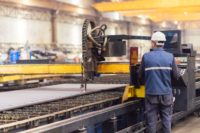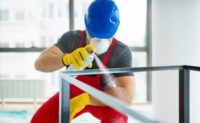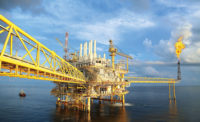Ensuring safety on an industrial site is critical, whether it’s a warehouse, construction site or loading dock. Many factors play a role in guaranteeing safety, making it challenging for facilities to keep workers out of harm’s way.
Any industrial site with employees working outside is subject to potentially dangerous weather conditions. Some areas deal with worse conditions than others, but everyone must be aware of current and forecasted weather conditions.
One less discussed weather condition in the industrial world is wind. High winds can create dangerous situations for employees working outdoors.
Here are some of the risks of high winds and mitigation efforts managers can use to keep workers, equipment and sites safe.
How high winds create safety risks
Severe storms and unpredictable gusts are sometimes unavoidable on industrial sites. However, these weather conditions can take workers by surprise and leave them vulnerable to facing an onslaught of safety risks. Taking proactive steps to mitigate these issues should be of the utmost importance for site managers and their employees.
High winds can affect an area due to thunderstorms, hurricanes, tornadoes or other weather events. A common wind storm consists of straight-line winds, which constantly blow between 10 and 40 mph and have sudden blasts up to 50 mph.
Hazards from high wind conditions vary depending on the industrial site. However, the list below includes some of the major safety risks associated with gusty winds:
- Objects blowing around and hitting workers or members of the public
- Eye injuries from dust and debris flying around
- Strains, sprains, or broken bones or joints when employees try to hold onto doors or objects
- Potentially heavy or sharp objects being forcefully blown from elevated surfaces
- Employees working at height being blown off if they are not secured
- Slips, trips and falls when employees are caught in wind gusts
- Breaking of branches of uprooted trees
- Collapses of buildings, scaffolding, fences, towers and other structures and heavy equipment
- Loose tools going airborne
- Broken power lines, resulting in an electrocution or fire hazard
This is a long list of potential safety risks that could cause injury or fatality on an industrial site. On top of that, strong winds can compromise a structure’s strength and lead to wind-induced building collapse or failure.
For example, residents who lose garage doors during hurricanes may have uncontrolled internal pressure build-up in their homes, leading to roof and wall blowouts. This can cause severe injury or even death. This may be less likely on an industrial site, but nobody wants employees to be injured due to high winds or wind-induced damage.
How industrial sites can ensure safety during high winds
Safety personnel must consider the dangerous impact high winds can have on their industrial site and how they can put employee safety at risk.
Employees should never work on elevated surfaces during high wind events. Tools must be kept secure and stowed away safely. All loose materials should be tied down using ropes, stakes or chains. Employees must wear hard hats at all times, especially during high winds, that meet OSHA requirements.
Additionally, eye protection is critical to prevent small debris particles from causing injuries. Any tasks that become too dangerous for employees should come to a screeching halt during high winds, and workers should ride out the storm indoors and out of harm’s way.
Explaining to employees that objects can become airborne or suddenly move at any moment is also vital. Stay updated on current and forecasted weather conditions to monitor wind speeds and prevent working during high winds when it becomes too dangerous.
Any downed power lines can create an electrocution or fire hazard and need to be reported immediately. Call the utility emergency center or the police if there are any downed power lines. Any partially built or temporary structures must be secured, and walls must be braced in the event of high winds.
Here are some other safety steps to consider when high winds come into play:
- Beware of debris falling from elevated surfaces.
- Avoid using heavy machines, such as cranes or hoisting equipment.
- Park trucks and equipment opposite where operators enter and exit.
- Use an anemometer to measure wind speeds.
- Shutter windows and doors, remain inside and bring in unsecured items.
Taking precautions is necessary for industrial sites in regions where high winds can occur. These steps will help employees remain safe in dangerous situations and retain the structural integrity of buildings.
Make safety a priority during high winds
Working in high wind conditions is challenging and can pose serious safety hazards to employees and other staff. Industrial site managers need to have plans in place for when weather conditions deteriorate and put people at risk. Taking proper precautions, training employees on what to do during high winds and ensuring protocols are met will help keep workers safe while on the job.



